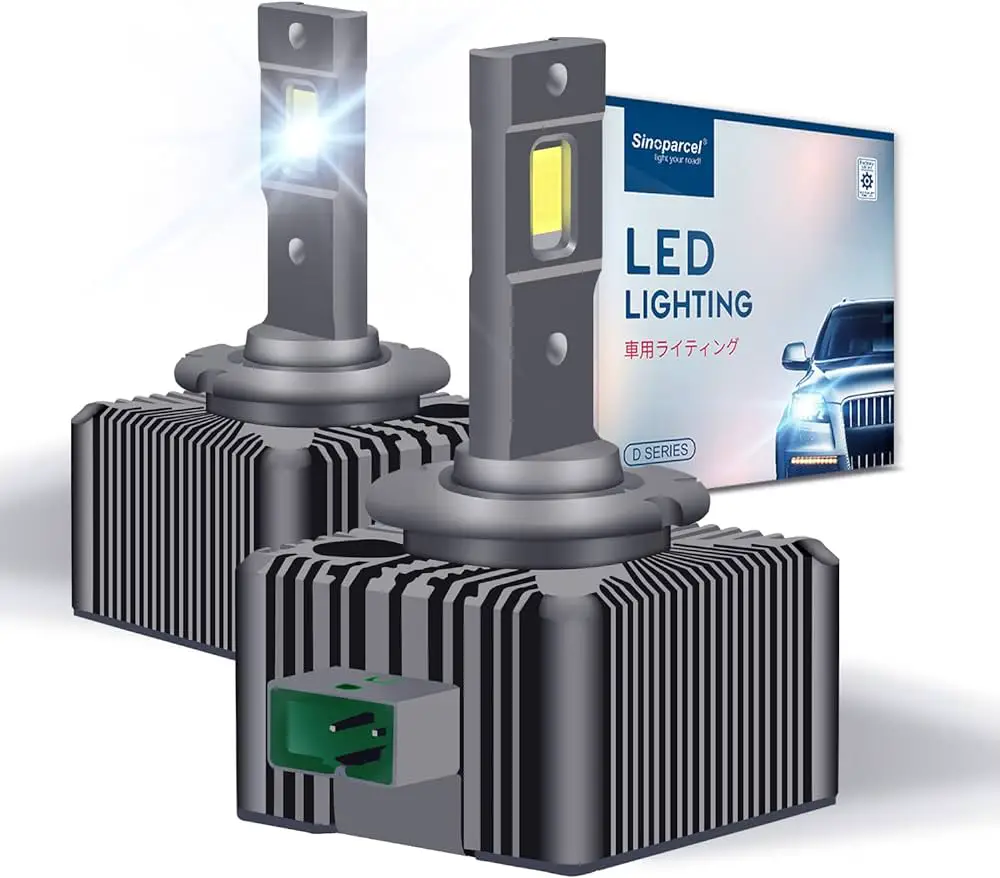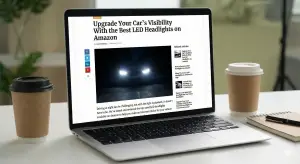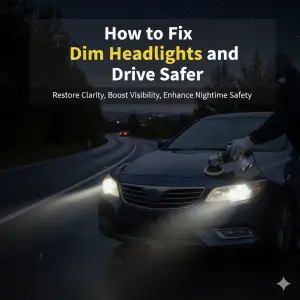Troubleshooting Xenon issues can be done by checking for physical signs of a bad ballast, such as burn marks, swollen or melted casing, or oil leakage. Additionally, intermittent HID functionality may indicate a need to replace the bulbs, inspect the ballast for malfunctioning, or check for blown fuses.
Improper installation, including loose or improperly grounded components, is a common cause of HID bulbs only working intermittently. Finally, it’s important to note that while xenon bulbs can burn out slowly over time, they do not all go out at once like filament lights.

Credit: www.amazon.com
Signs Of A Bad Xenon Hid Ballast – Complete Guide
If you’re experiencing troubleshooting issues with your Xenon HID ballast, there are signs to look out for. Physical signs of a bad ballast include burn marks, swollen or melted casing, and oil leakage. Additionally, intermittent HID bulb operation may indicate improper installation or faulty components that need to be inspected.
Overview Of Xenon Hid Ballasts
The Xenon HID ballast is an important component of the HID lighting system in vehicles. It plays a crucial role in providing the necessary voltage and current to ignite and power the Xenon bulbs. However, like any electronic device, the ballast can sometimes malfunction, causing issues with the headlights. In this complete guide, we will explore the signs of a bad Xenon HID ballast and provide troubleshooting tips to help you identify and fix any problems.
Common Signs Of A Bad Ballast
A bad Xenon HID ballast can exhibit several common signs that indicate something is wrong with the system. These signs can include:
- Headlights not turning on or only turning on intermittently
- Dim or flickering lights
- Uneven or inconsistent lighting
- Delayed startup of the headlights
Physical Signs Of A Bad Ballast
In addition to the common signs mentioned above, there are also physical signs that can indicate a bad Xenon HID ballast. Some of these physical signs include:
- Burn marks on the ballast
- Swollen, melted, or damaged/broken casing
- Perforated casing
- Oil leakage in older ballasts
Troubleshooting A Bad Ballast
If you suspect that your Xenon HID ballast is bad, there are a few troubleshooting steps you can take to confirm the issue. These steps include:
- Swapping parts from side to side to see if the problem follows
- Swapping ballast computers to determine if the issue is with the ballast
- Testing the ballast to check for voltage output
- Swapping the igniter to rule out any issues with the igniter
- Checking the light bulb for any signs of damage or malfunction
- Inspecting the grounds for a secure connection
By following these troubleshooting steps, you can pinpoint the cause of the issue and take appropriate action to fix or replace the faulty Xenon HID ballast.
How To Diagnose & Fix Hid Headlight Bulbs Ballast Not Working
High-intensity discharge (HID) headlight bulbs are a popular choice among car enthusiasts due to their bright and crisp illumination. However, like any other component, HID headlight bulbs can encounter issues over time. One common problem is when the ballast, which provides the correct voltage to the bulbs, stops working. In this blog post, we will discuss three possible problems with HID headlight bulbs and how to diagnose and fix the issue.
When your HID headlight bulbs are not working, there can be three potential issues to consider:
- Burnt-out bulb: HID bulbs have a lifespan, and eventually, they may burn out and require replacement.
- Malfunctioning ballast: The ballast is responsible for providing the necessary power to the bulbs. If the ballast is faulty, it can cause the bulbs to stop working.
- Blown fuse: A blown fuse can disrupt the connection between the ballast and the bulbs, resulting in the bulbs not turning on.
To identify the source of the problem, follow these steps:
- Check the bulbs for any physical signs of damage, such as burn marks, swollen casing, or oil leakage. If you notice any of these signs, replacing the bulb is necessary.
- Next, test the ballast by swapping it with a known working ballast from the opposite side. If the issue persists, it indicates that the ballast is the problem.
- If the ballast is suspected to be faulty, consider replacing it with a new one. Swapping the ballasts is a simple and effective solution to fix the issue.
Installing a New Bulb and Testing the HIDs:
Once you have determined that the ballast is functioning correctly, you can proceed with the following steps:
- Install a new HID bulb if the previous one was deemed faulty. Carefully insert the bulb into the headlight assembly, taking care not to touch the glass part of the bulb with bare hands, as it can cause damage.
- After installing the new bulb, test the HID system by turning on the headlights. Ensure that the bulbs illuminate properly and provide the desired brightness.
If the issue persists even after replacing the bulb and confirming the functionality of the ballast, further troubleshooting is required:
- Remove the potentially problematic bulb once again to inspect for any loose connections or wiring issues. Ensure that all connections are secure and properly seated.
- Check the grounds for any loose or corroded connections. A poor ground connection can cause the HID bulbs to malfunction.
By following this troubleshooting process, you should be able to diagnose and fix the issue with HID headlight bulbs when the ballast is not working.
Hid Headlight Ballast Replacement
Having trouble with your HID headlights? If you’re experiencing Xenon troubleshooting issues and need to replace your HID headlight ballast, follow these steps for a quick and easy fix.
Overview Of Hid Headlight Ballasts
An HID (High-Intensity Discharge) headlight ballast is a crucial component in HID lighting systems. It is responsible for regulating the electrical current supplied to the HID bulbs, which helps create the bright and efficient lighting that HID headlights are known for. The ballast acts as a power controller, igniting the bulbs and maintaining a steady flow of electricity to keep them illuminated. Without a functioning ballast, your HID headlights won’t work properly or may not work at all.Introduction To Xentec Slim Hid Ballast
Xentec Slim HID Ballast is a reliable and popular choice when it comes to HID headlight ballast replacements. Designed with advanced technology, Xentec Slim HID Ballasts are known for their compact size, ease of installation, and improved performance. These ballasts are compatible with various vehicle makes and models, making them a versatile option for those seeking a solution to their HID headlight issues.Introduction To Xentec Super Slim Digital Xenon Hid Ballast
If you’re looking for an even sleeker and more advanced HID headlight ballast, the Xentec Super Slim Digital Xenon HID Ballast is worth considering. With its ultra-slim design and digital technology, this ballast not only delivers reliable power to the HID bulbs but also provides enhanced compatibility and brightness. The Xentec Super Slim Digital Xenon HID Ballast is designed to resist vibrations and shocks, ensuring longevity and durability.Philips Xenon Hid Headlight Ballast
For those who prefer a trusted and reputable brand, the Philips Xenon HID Headlight Ballast is a top choice. Philips is known for its high-quality automotive lighting products, and their HID ballasts are no exception. These ballasts are designed to deliver optimal performance and longevity, ensuring that your HID headlights shine bright for miles to come. With Philips Xenon HID Headlight Ballasts, you can expect reliability and peace of mind.Troubleshooting Common Issues With Hid Ballasts
Even with high-quality ballasts, issues can arise. It’s important to troubleshoot and address any problems promptly for the best performance of your HID headlights. Here are some common issues and their potential solutions:- Ballast not powering on: – Check the connections to ensure they are secure and free from corrosion. – Inspect the wiring for any damages or loose connections. – Replace the fuse if it is blown. – Test the ballast with a new bulb to rule out a faulty ballast. – Consider professional assistance if the issue persists.
- Dim or flickering lights: – Ensure the bulbs are securely and properly seated in the headlight assembly. – Inspect the wiring for any damages or loose connections. – Check the ballast for any signs of overheating or damage. – Replace the bulb if it appears to be defective.
- Intermittent operation: – Check the connections to ensure they are secure and free from corrosion. – Inspect the wiring for any damages or loose connections. – Test the ballast with a new bulb to rule out a faulty ballast. – Consider replacing the ballast if the issue persists.
- Uneven lighting: – Ensure the bulbs are properly aligned and seated in the headlight assembly. – Check for any obstructions or dirt on the lens that may affect the light distribution. – Clean the lens and the reflector if necessary. – Consider professional assistance if the issue persists.
How Do I Know If My Xenon Ballast Is Bad?
If you’re experiencing issues with your Xenon HID headlights, it’s essential to determine whether the problem lies with the ballast. The ballast plays a crucial role in providing the correct voltage to the HID light bulbs, and a faulty ballast can cause a range of problems. To help you diagnose the issue effectively, here are some physical signs to look out for:
Physical Signs Of A Bad Ballast:
- Burn marks on the ballast
- Swollen or melted casing
- Damaged or broken wires
Identifying Burn Marks On The Ballast:
Burn marks on the ballast can be a clear indication of a problem. These marks can occur due to various reasons, such as excessive heat or electrical faults. To identify burn marks, visually inspect the ballast for any discoloration or blackened areas. If you notice burn marks, it’s highly likely that your ballast needs to be replaced.
Swollen Or Melted Casing As Indications Of A Bad Ballast:
Another physical sign to look out for is swollen or melted casing. This can occur when the ballast overheats, causing the casing to deform or melt. Inspect the ballast for any visible changes in shape, such as bulging or warping. Additionally, check for any signs of melted plastic on the surface of the ballast. These indications suggest a faulty ballast that should be addressed promptly.
Understanding Damaged Or Broken Wires In The Ballast:
Finally, inspect the ballast for any damaged or broken wires. Over time, the constant exposure to heat and vibrations can cause the wires to become brittle or disconnected. Carefully examine the wiring connections and look for any signs of fraying, corrosion, or loose connections. Damaged or broken wires can impair the functionality of the ballast and should be repaired or replaced as necessary.
By paying attention to these physical signs, you can determine whether your Xenon ballast is bad and take appropriate action to rectify the issue. Remember, a malfunctioning ballast can lead to unreliable lighting and compromised visibility, so it’s essential to address the problem promptly to ensure your safety on the road.
Frequently Asked Questions On Xenon Troubleshooting Issues
How Do I Know If My Xenon Ballast Is Bad?
Physical signs of a bad xenon ballast include: burn marks, swollen/melted/damaged casing, perforated casing, and oil leakage (in older ballasts). Additionally, if the HID bulbs only work intermittently or don’t turn on at all, the ballast could be malfunctioning or a fuse might be blown.
Improper installation and grounding can also cause issues with HID systems.
Why Does My Hid Work Intermittently?
The HID might work intermittently due to possible bulb replacement, malfunctioning ballast, or blown fuse. Each component, including the bulb, ballast, and fuse, needs to be individually inspected for any issues. Improper installation and grounding can also cause the HID bulb to work only sometimes.
Why Does My Hid Bulb Only Work Sometimes?
Improper installation, such as loose connections or inadequate grounding, can cause HID bulbs to work intermittently. Inspect the bulb, ballast, and wiring for proper installation and protection against moisture. Ensure proper grounding for optimal functionality.
Can Xenon Bulbs Burn Out?
Yes, xenon bulbs can burn out slowly over time, similar to street lights. If your xenon headlight bulb is not working, it may need to be replaced. Physical signs of a bad xenon ballast include burn marks, swollen or melted casing, and oil leakage in older ballasts.
Improper installation and grounding can also cause intermittent operation.
Conclusion
In troubleshooting Xenon issues, it’s important to thoroughly diagnose and test each component, such as the ballast, bulb, and wiring. Look out for physical signs of a bad ballast, including burn marks, swollen or melted casing, and oil leakage. Additionally, check for proper installation and grounding, as these can contribute to intermittent bulb operation.
Remember to inspect and replace any faulty components to ensure optimal performance of your Xenon system.



